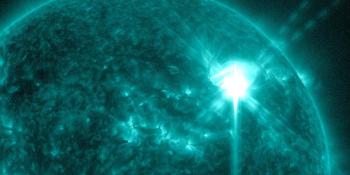Viewing archive of środa, 31 stycznia 2001
Raport aktywności słonecznej
Any mentioned solar flare in this report has a scaling factor applied by the Space Weather Prediction Center (SWPC). Because of the SWPC scaling factor, solar flares are reported as 42% smaller than for the science quality data. The scaling factor has been removed from our archived solar flare data to reflect the true physical units.
Raport aktywności słoneczno- geomagnetycznej 2001 Jan 31 2200 UTCPrzygotowane przez NOAA © SWPC i przetworzone przez SpaceWeatherLive.com
Połączenie raportów USAF/NOAA o słonecznej i geofizycznej aktywności
Numer SDF 031 wydany w 2200Z na 31 Jan 2001IA. Analiza aktywności regionów słonecznych i aktywność od 30-2100Z do 31-2100Z Solar activity has been low. The greatest activity of
note was an optically uncorrelated C2 flare at 30/2237 UTC. A
bright surge on the disk near spotless region 9216 (S15W84) was also
observed at 31/1536 UTC, but with only minor accompanying x-ray
enhancement. Region 9330 (N26E57) has rotated into full view as the
largest region on the disk (230 millionths coverage in white light,
in an Eao-Beta configuration), but produced no activity of note
during the period.
IB. Prognoza aktywności słonecznej
Solar activity is expected to be
predominantly low, with only isolated chances for moderate activity
during the next three days.
IIA. Podsumowanie aktywności geofizycznej 30-2100Z do 31-2100Z
Geomagnetic field activity ranged from quiet to minor storm levels.
Shock passage associated with the CME of January 28 was observed at
the ACE satellite at 31/0742 UTC, with a subsequent sudden impulse
(17 nT) observed at Boulder at 31/0803 UTC. Unsettled to active
conditions have predominated since, with an isolated period of
minor storming recorded for higher latitudes during 31/0900-1200
UTC.
IIB. Prognoza aktywności geofizycznej
The geomagnetic field is
expected to be at quiet to active levels through February 1,
reducing to quiet to unsettled levels for February 2-3.
III. Prawdopodobieństwa zdarzenia 01 Feb do 03 Feb
| Klasa M | 30% | 30% | 30% |
| Klasa X | 05% | 05% | 05% |
| Proton | 01% | 01% | 01% |
| PCAF | green | ||
IV. Przepływ 10,7 cm z Penticton
Zaobserwowano 31 Jan 153 Przewidywane 01 Feb-03 Feb 155/160/165 Średnia z 90 dni 31 Jan 172
V. Indeks geomagnetyczny A
Zaobserwowano Afr/Ap 30 Jan 003/004 Szacowane Afr/Ap 31 Jan 013/018 Przewidywane Afr/Ap 01 Feb-03 Feb 008/008-005/005-005/005
VI. Prawdopodobieństwa aktywności geomagnetycznej 01 Feb do 03 Feb
| A. Średnie szerokości geograficzne | |||
|---|---|---|---|
| Aktywne | 25% | 25% | 20% |
| Słaba burza | 10% | 05% | 05% |
| Bardzo znacząca burza | 05% | 01% | 01% |
| B. Wysokie szerokości geograficzne | |||
|---|---|---|---|
| Aktywne | 30% | 25% | 25% |
| Słaba burza | 15% | 10% | 05% |
| Bardzo znacząca burza | 05% | 05% | 01% |
<< Idź do codziennego przeglądu
Najnowsze wiadomości
Najnowsze wiadomości z forum
AR3663 242AR3664 87Incoming Active Regions 238Sporadic E and Flare activity 21Filaments and prominences 79
Więcej tematówWesprzyj SpaceWeatherLive.com!
Wielu ludzi odwiedza SpaceWeatherLive aby śledzić aktywność słoneczną lub sprawdzić czy jest szansa na zaobserwowanie zorzy polarnej. Niestety, większy ruch na stronie oznacza większe koszty utrzymania serwera. Dlatego, jeśli jesteś zadowolony ze strony SpaceWeatherLive, zachęcamy do wspierania nas finansowo. Dzięki temu będziemy mogli utrzymać naszą stronę.

Fakty na temat pogody kosmicznej
| Ostatnie rozbłyski klasy X | 2024/05/06 | X4.52 |
| Ostatnie rozbłyski klasy M | 2024/05/07 | M3.2 |
| Ostatnia burza geomagnetyczna | 2024/05/06 | Kp5 (G1) |
| Spotless days | |
|---|---|
| Ostatni dzień bez skazy | 2022/06/08 |
| Monthly mean Sunspot Number | |
|---|---|
| kwietnia 2024 | 136.5 +31.6 |
| Last 30 days | 161.9 +69.9 |


